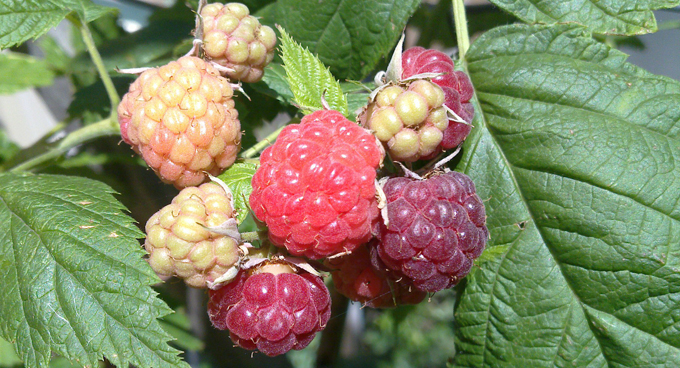If you can grow apples you can grow raspberries, and why wouldn’t you? The sweet juicy fruit is delectable when picked ripe and warm from the canes, truly placing the taste of the sun on your tongue. Nutritionally dense and a fantastic snack for kids, raspberries require a small amount of preparation and ongoing care which will yield great results.
Canes are available in nurseries in winter as bare-rooted stock. When you plant your raspberries prune them to about 20cm from ground level.
Cultivation
Berries are a long-term crop and it is worth preparing the soil well and removing all weeds before planting. Add plenty of well-rotted manure and compost in order to create a rich, well-drained, slightly acidic soil. If you have a heavy clay soil, build the beds up or add gypsum prior to planting. Mulch berries well to keep roots cool and moist, and to suppress weeds.
Plant your raspberries in a northerly to north-easterly aspect and avoid planting them in an area where you have grown tomatoes, capsicum and eggplants in the past three years to avoid the risk of Verticillium wilt.
Feed with blood and bone or well-rotted manure in spring and autumn.
Pruning and training
Raspberry varieties fall into two categories: summer and autumn fruiting.
Summer fruiting varieties will fruit on two year old canes. The two year old canes are called floricanes and the new season canes are called primocanes.
Each year remove the floricanes that produced fruit and tie up the new season’s primocanes to a wire trellis. Tying the canes up in bundles can make them easier to manage. The smaller autumn harvest will be produced on the tips of the primocanes and these can be trimmed to just below the fruit after harvest. The trellis may consist of two or three wires positioned about 50cm apart, strung securely between two sturdy posts.
Autumn fruiting raspberries can simply be cut back to ground level and the new spring canes tied up as they grow.

Raspberry – Chilcotin
Heavy cropper, excellent fruit size and quality but can be crumbly at times. Good disease resistance.
Canes need to be thinned during growing season.
Mid Season: summer for 4-5 weeks with a small late autumn crop.
Raspberry – Chilliwack
Excellent fruit size and quality but may be crumbly at times. Used for fresh fruit, jam and cooking. Berries retain gloss and colour when preserved.
Mid season: fruit produced in summer for 4 to 5 weeks followed by a small late autumn crop. Good disease resistance. Canes need thinning during the growing season.
Raspberry – Heritage
Medium red firm berries, good aromatic flavour, excellent quality.
A low chill cultivar. Thorny canes.
Mid season: February for 8 to 12 weeks.
Use for fresh fruit, jam and cooking.
Raspberry – Neika
Delicate soft fruit with a sweet taste.
Early season: harvest November to December.
Raspberry – Nootka
Large, bright red, firm fruit, good flavour.
Fruits on new growth. Heavy crops. Good disease resistance.
Mid season: summer for 4 to 5 weeks.
Fresh fruit, jam and cooking.
Raspberry – Skeena
Medium-sized, bright, glossy, red conical berries, excellent flavour.
Thornless, low chill cultivar with medium-high yield.
Early season: summer for four weeks.
Fresh fruit, jam and cooking, retains colour and gloss in storage.
Raspberry – Willamette
Large berry easily detached, good flavour,
Hardy with some virus resistance.
Early to mid-season.
Frozen, fresh, cooking or excellent for preserves.
Fresh or frozen fruit and cooking, excellent for jam, dense and not seedy.
Stores well.
Photographs
Photographs by Tracey Martin (SGA)
Related Articles:
Tomato Brown Rugose Fruit Virus (ToBRFV)
Tomato Brown Rugose Fruit Virus (ToBRFV) is a plant virus that causes severe crop losses (up to 75%) in tomatoes, but also in peppers (capsicums and…
Garden Journaling – Slow down to tune in.
As we move through the year and our gardens evolve, there's something magical about documenting the journey. Garden journaling is an art that enables…


